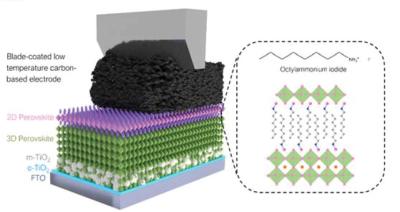Researchers from Fraunhofer Institute for Solar Energy Systems ISE, EPFL, Korea Basic Science Institute (KBSI) and Morocco's Abdelmalek Essaadi University have developed a perovskite solar cell with a carbon electrode that achieved 18.5% efficiency.
 Schematic diagram of the investigated low-temperature carbon electrode-based PSC with 3D/2D perovskite treated by OAI. Image from study
Schematic diagram of the investigated low-temperature carbon electrode-based PSC with 3D/2D perovskite treated by OAI. Image from study
The solar cell also reportedly retained 82% of their efficiency after 500 hours of continuous illumination. The cell is produced via all low-temperature processes that could likely be scaled into low-cost, large-scale manufacturing ' making the approach attractive despite achieving lower efficiency than record-setting cells.
The team explained that C-PSCs create a problem elsewhere in the cell, leading to performance losses at the point where the carbon electrode meets the perovskite layer. And to overcome this, the team worked to develop a blocking layer to place between the two.
They deposited another perovskite formulation onto the active cell layer, and using various imaging techniques, they were able to confirm that this additional layer served to block electrons from movement in the 'wrong' direction, and increase the cell performance.
The group fabricated cells that reached 18.5% efficiency and maintained 82% of this after 500 hours of constant, one-sun illumination. A control device fabricated without the blocking layer achieved 15.7% initial efficiency, and had lost 63% of this after 200 hours under illumination.
'We believe that the approach of the employment of 2D perovskite as an EBL can help pave the way for the future practical development of fully printable C-PSCs with high efficiency and long-term stability,' the group concluded.

